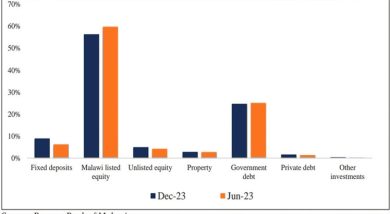Loan default likely to continue—RBM

The Reserve Bank of Malawi said the financial sector is well capitalised, but credit risk remains high with ratio of non-performing loans (NPLs) to gross loans and leases jumping to 11.8 percent in March 2013 from 6.5 percent in September 2012.
The RBM’s latest financial stability report covering the period September 2012 to March 2013 indicates that the NPLs that have been building up over the review period are likely to continue affecting the current and projected profitability of lending institutions.
As such, the current high loan delinquencies are likely to continue stressing the loan books of the financial intermediaries in the coming months.
The RBM report indicates that between March and September 2013, threats to Malawi’s financial system stability are expected to subside, but the impact of some prevailing risks is likely to spill over in the following months.
But in a foreword to the report, RBM Governor Charles Chuka said: “As evidenced by assessments of the sectoral soundness indicators, the life insurance sector in Malawi showed an improvement in capital positions, asset quality and liquidity. The pension sector registered significant growth in 2012 and is expected to continue expanding further in 2013.”
He said the microfinance sector continued to grow while the payments and settlements system provided safe and efficient payment services in the period, mitigating all financial and operational risks.
Economic activity in the first half of 2012 remained subdued affecting the financial stability, but picked toward the end of the year and into 2013.
Figures show that gross domestic product (GDP) growth eased from 3.8 percent in 2011 to a tepid 1.8 percent in 2012, and this year, growth is expected to rebound to five percent.
And with subdued economic growth, a high inflationary environment and tight monetary and liquidity conditions, 2012 was a bad year for the country’s banking sector, but conditions began to ease in the first quarter [January to March] of 2013.
The RBM reported that the deteriorating macroeconomic environment largely explained the adverse developments in the credit market.
“Rising inflation and high lending rates adversely affected borrowers’ ability to service outstanding facilities. Consequently, default risk and non-performing loans elevated. These exerted downward pressure on financial intermediation and adversely affected profit avenues for financial intermediaries,” reads the report.
Owing to high lending rates in commercial banks which peaked at above 40 percent, the non-bank lending institutions also experienced high cost of funding and, in turn, extended credit to their clients at even higher rates.
As a result of this, loan delinquencies in the non-banking lending institutions also increased.
Inflation currently at 27.9 percent as of June 2013, but its pressure heightened in February this year reaching 37.9 percent.
The rate started receding in March [36.4 percent], but was and is still high compared to historical levels. It is largely affected by the low supply of food which accounts for 50.2 percent in the Consumer Price Index (CPI)—a measure that examines the weighted average prices of consumer goods and services.
High and unstable inflation erodes prospects to save and undermines borrowers’ ability to service outstanding loan facilities from financial institutions thus to address the rising inflationary pressure, monetary authorities maintained a tight stance.
On the interest rate, the RBM in December 2012 increased the policy rate to 25 percent from 21 percent, affecting the funding costs of lending institutions which reacted by raising their prime lending rates to an average of 36.17 percent from 31.42 percent.
In March this year, lending institutions revised their lending rates upwards again to 37.50 percent from 36.17 percent, raising concerns about potential adverse impacts on the quality of financial intermediaries’ loan books, hence, adverse pressure on non performing facilities.





